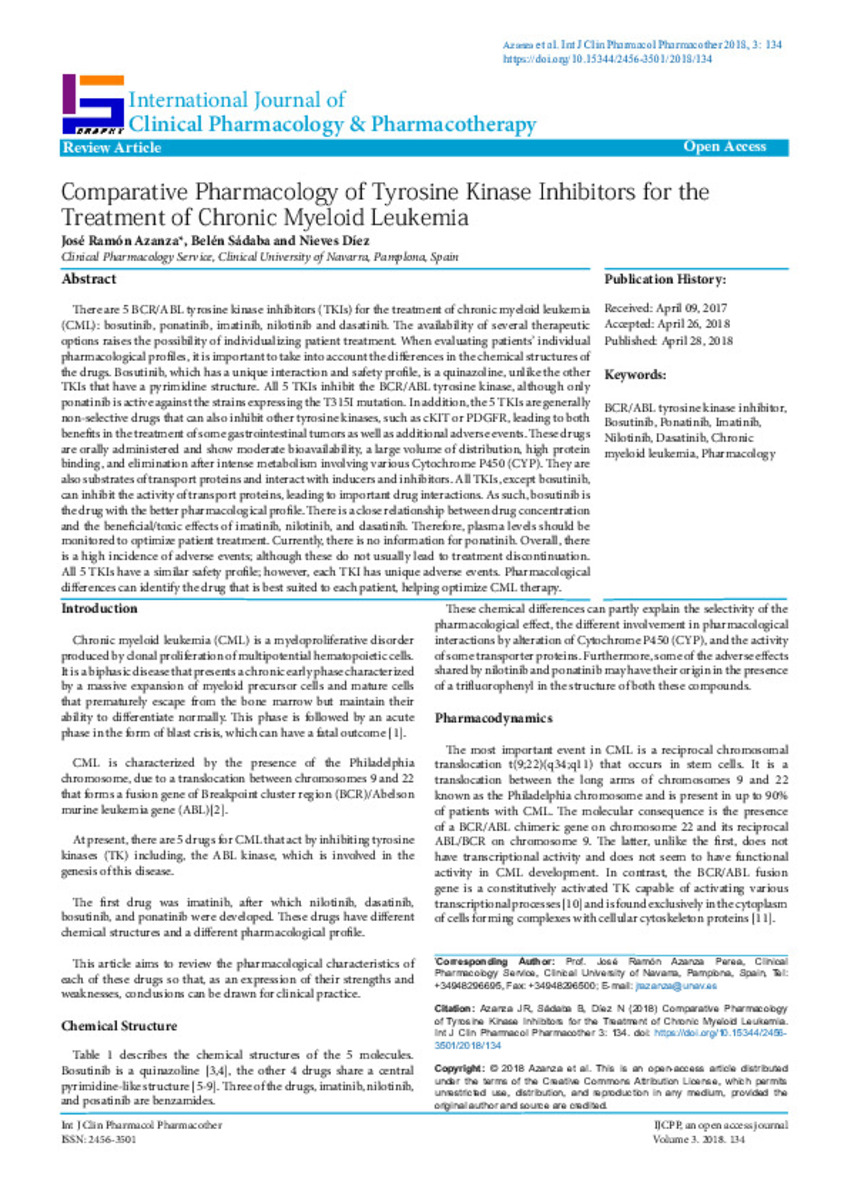Full metadata record
| DC Field | Value | Language |
|---|---|---|
| dc.creator | Azanza, J.R. (José Ramón) | - |
| dc.creator | Sadaba, B. (Belén) | - |
| dc.creator | Díez, N. (Nieves) | - |
| dc.date.accessioned | 2022-12-05T08:27:22Z | - |
| dc.date.available | 2022-12-05T08:27:22Z | - |
| dc.date.issued | 2018 | - |
| dc.identifier.citation | Azanza, J.R. (José Ramón); Sadaba, B. (Belén); Díez, N. (Nieves). "Comparative pharmacology of tyrosine kinase inhibitors for the treatment of chronic myeloid leukemia". International journal of clinical pharmacology & pharmacotherapy. 3 (134), 2018, | es |
| dc.identifier.issn | 2456-3501 | - |
| dc.identifier.uri | https://hdl.handle.net/10171/64793 | - |
| dc.description.abstract | There are 5 BCR/ABL tyrosine kinase inhibitors (TKIs) for the treatment of chronic myeloid leukemia (CML): bosutinib, ponatinib, imatinib, nilotinib and dasatinib. The availability of several therapeutic options raises the possibility of individualizing patient treatment. When evaluating patients’ individual pharmacological profiles, it is important to take into account the differences in the chemical structures of the drugs. Bosutinib, which has a unique interaction and safety profile, is a quinazoline, unlike the other TKIs that have a pyrimidine structure. All 5 TKIs inhibit the BCR/ABL tyrosine kinase, although only ponatinib is active against the strains expressing the T315I mutation. In addition, the 5 TKIs are generally non-selective drugs that can also inhibit other tyrosine kinases, such as cKIT or PDGFR, leading to both benefits in the treatment of some gastrointestinal tumors as well as additional adverse events. These drugs are orally administered and show moderate bioavailability, a large volume of distribution, high protein binding, and elimination after intense metabolism involving various Cytochrome P450 (CYP). They are also substrates of transport proteins and interact with inducers and inhibitors. All TKIs, except bosutinib, can inhibit the activity of transport proteins, leading to important drug interactions. As such, bosutinib is the drug with the better pharmacological profile. There is a close relationship between drug concentration and the beneficial/toxic effects of imatinib, nilotinib, and dasatinib. Therefore, plasma levels should be monitored to optimize patient treatment. Currently, there is no information for ponatinib. Overall, there is a high incidence of adverse events; although these do not usually lead to treatment discontinuation. All 5 TKIs have a similar safety profile; however, each TKI has unique adverse events. Pharmacological differences can identify the drug that is best suited to each patient, helping optimize CML therapy. | es_ES |
| dc.language.iso | eng | es_ES |
| dc.publisher | Graphy | es_ES |
| dc.rights | info:eu-repo/semantics/openAccess | es_ES |
| dc.subject | BCR/ABL tyrosine kinase inhibitor | es_ES |
| dc.subject | Bosutinib | es_ES |
| dc.subject | Ponatinib | es_ES |
| dc.subject | Imatinib | es_ES |
| dc.subject | Nilotinib | es_ES |
| dc.subject | Dasatinib | es_ES |
| dc.subject | Chronic myeloid leukemia | es_ES |
| dc.subject | Pharmacology | es_ES |
| dc.title | Comparative pharmacology of tyrosine kinase inhibitors for the treatment of chronic myeloid leukemia | es_ES |
| dc.type | info:eu-repo/semantics/article | es_ES |
| dc.description.note | This is an open-access article distributed under the terms of the Creative Commons Attribution License, which permits unrestricted use, distribution, and reproduction in any medium, provided the original author and source are credited. | es_ES |
| dc.identifier.doi | 10.15344/2456-3501/2018/134 | - |
| dadun.citation.number | 134 | es_ES |
| dadun.citation.publicationName | International journal of clinical pharmacology & pharmacotherapy | es_ES |
| dadun.citation.volume | 3 | es_ES |
Files in This Item:
Statistics and impact
Items in Dadun are protected by copyright, with all rights reserved, unless otherwise indicated.






